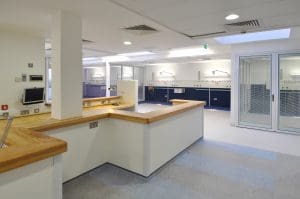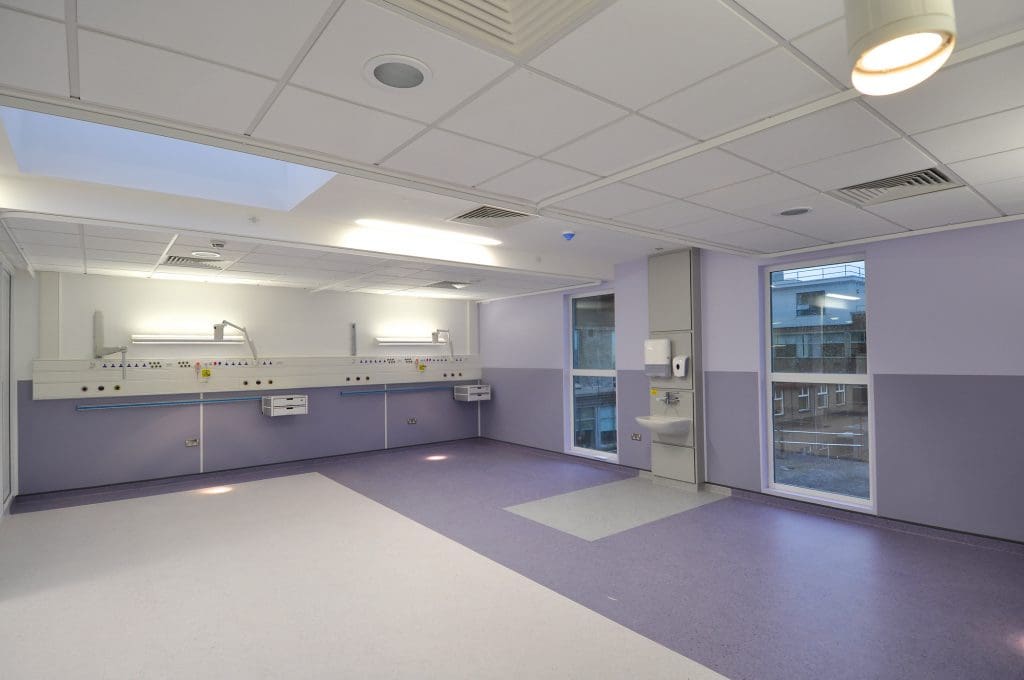Here, we interview Nathalie Meunier, Healthcare Specialist at The McAvoy Group about the use of offsite solutions for healthcare schemes, some of the lessons learned from ProCure21+, and future developments in offsite design and technology.
In your opinion, have there been any ‘lessons learned’ from Procure 21+?
The principle of repeatable room designs and standardised components that ProCure21+ promotes to improve cost-efficiency, quality and risk, lends itself very well to offsite construction and design for assembly.
The ethos of ProCure21+ is about collaborative and partnership working and an integrated approach, and again there is a good fit with offsite solutions which require early engagement to optimise the benefits.
Modular solutions can be used to take an element of a major hospital redevelopment off the critical path. Space can be unlocked to allow early commencement of the wider development whilst maintaining the highest standards of patient care, which can be a significant benefit for ProCure21+ and ProCure22 contractors.
Do you anticipate further developments in design and technology over the next five to ten years and what are they likely to be?
The use of virtual reality technology will increase in importance for healthcare schemes to enhance stakeholder collaboration.
McAvoy already has the capabilities to put the client and end users into a virtual building. This gives clinicians the opportunity to ‘walk round’ the building at the earliest design stage to feel and experience its functionality, assess usability, patient flows, layouts and adjacencies. This could be hugely beneficial for stakeholder engagement, streamlining the design process, and facilitating better and more informed decision making.
McAvoy is constantly looking at new materials and technologies to improve how buildings perform throughout their lifecycle. We envisage that the use of advanced composites will enter into offsite construction, developed and widely used in similar high volume manufacturing sectors.
We are working towards more automated construction, using smarter processes and DFMA (Design for Manufacture and Assembly) principles. The structural design of our offsite buildings will then evolve to capitalise on the advanced manufacturing processes for even greater cost and time efficiencies.
We also anticipate more hybrid building solutions – a combination of modular and site-based building techniques to provide optimum solutions for large healthcare schemes. This could be for example, two wings of ward or consulting accommodation linked by a traditionally-constructed atrium space. And we have the project management expertise to manage both elements to simplify procurement.
How does offsite technology maximise NHS budgets?
With the latest advances in offsite technology, healthcare buildings constructed offsite are fully futureproof to maximise NHS budgets. Facilities can easily be reconfigured and adapted to meet changing service needs, for example conversions from wards to offices. Modular facilities are built to permanent standards in compliance with NHS requirements, and can have the flexibility to be removed and relocated to another hospital site if required.
Offsite solutions allow highly constrained hospital sites where space for expansion is severely restricted, to be reconfigured to optimise operational efficiency. Modular buildings can be located on completely enclosed sites that are inaccessible for traditional construction. Existing facilities can be expanded vertically or horizontally.
Modular buildings can be sited on steel platforms to extend the upper floors of hospital buildings to increase clinical space whilst maintaining critical patient flows.
These innovative solutions give healthcare providers greater flexibility to increase capacity and revenue streams, whilst meeting the rising demand for patient care.
An example is a project we delivered for Daisy Hill Hospital for Southern Health and Social Care Trust where we provided two additional operating suites on a 15m high steel gantry to connect the new facilities to existing clinical space.
Time and cost overruns on both public and private sector building projects are still unacceptably high. By contrast, offsite construction can significantly reduce risk with much greater assurance of delivery on time and on budget.
Interim modular buildings can be supplied to help NHS trusts increase capacity during peak periods such as the winter months or for decant use to maintain service levels while other hospital assets are refurbished or redeveloped. Accommodation provided on hire can help to reduce waiting times and the increased revenue for treating these additional patients could recover the cost of hiring the building.
Is the healthcare sector embracing offsite technology and if so, why?
The healthcare sector is not embracing offsite as much as other sectors, such as education. Its use is not driven at Government level in the same way as the Education and Skills Funding Agency has embraced offsite technology for schools. The procurement strategy for school projects and the introduction of education modular frameworks have been specifically developed to increase the use of offsite solutions.
However, with the latest technical advancements in offsite construction, there need be no compromise on architectural design, performance, or appearance for healthcare projects. Modular buildings can be used for wards, theatres, diagnostics and support facilities such as offices – and from extensions to complete hospitals. They can be used to create award-winning architecture and prominent, landmark schemes – or buildings that complement existing facilities and with greater efficiency.




